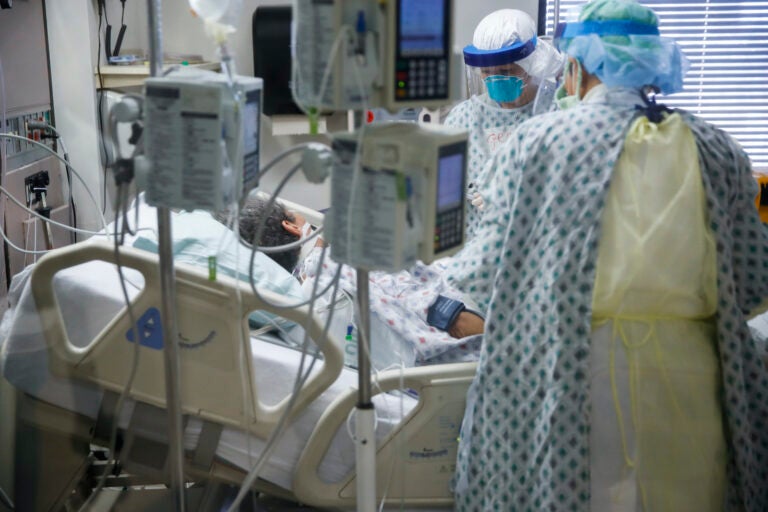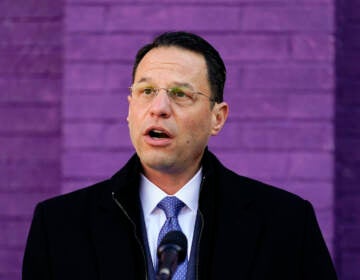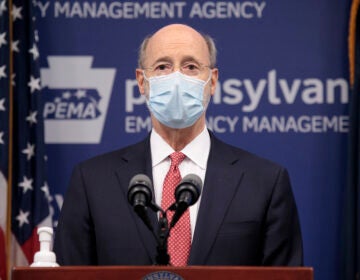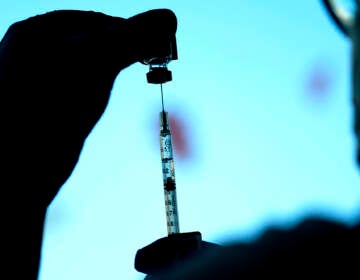Why so many COVID-19 deaths in Pa. will never be counted
Test kit shortages, at-home deaths, and obstacles facing hospitals mean relying on official results alone won’t capture the true toll of the coronavirus.

Intensive care unit staff members care for a COVID-19 patient, Monday, April 20, 2020, at St. Joseph's Hospital in Yonkers, N.Y. (John Minchillo/AP Photo)
Are you on the front lines of the coronavirus? Help us report on the pandemic.
In Pennsylvania, something miraculous happened this week: The number of confirmed fatalities from COVID-19 went down by nearly 200.
State Health Secretary Rachel Levine said Pennsylvania had begun to strike “probable” COVID-19 deaths to reduce “confusion” around its official death tally.
“Further review has determined that we need more information before we can attribute them to a death related to COVID-19,” she said.
But as officials move to reopen the state based in part on this data, both national and local medical professionals said Pennsylvania should be less worried the fatalities count is too high and more worried it’s much, much too low. Experts said there is little doubt that official COVID-19 counts around the globe have understated the full scope of pandemic deaths.
Andrew Noymer, associate professor of population health and disease prevention at the University of California, Irvine, said it was virtually guaranteed that a significant number of patients with COVID-19 were either not being tested or otherwise misclassified.
“If someone walks into a hospital already in respiratory distress, the hospital is more interested in keeping them alive … than they are in getting a test result,” Noymer said. “Or they’ll say ‘We’re not wasting a test on a dead body,’ and the cause of death may just be recorded as pneumonia.”
In Pennsylvania, as elsewhere, test kit shortages, an increase in at-home deaths, and obstacles facing hard-hit hospitals mean many who succumbed to the virus may not be recorded as such.
According to local medical experts, that means relying on confirmed test results alone would never capture the true toll of the virus.
“Whether it’s from COVID or not, the bottom line is they’re dying at a much higher rate than they ever were dying last year or the year before,” said Jay Giri, a cardiologist at University of Pennsylvania Medical Center.
Who counts as COVID?
In Philadelphia, COVID-19 deaths are submitted to the Health Department by individual hospitals. Hospitals also report deaths to the Pennsylvania Department of Health, and officials there classify them as confirmed if the state has a positive COVID-19 test result on record for the deceased. Anyone with symptoms but no test results who dies is now considered “probable.”
But the whirlwind of coronavirus care in the ICU means patients might easily be miscategorized, said David Fleece, chief information officer at Temple University Hospital. He said doctors often code a patient as “suspected COVID” on his or her chart before test results come in, if that patient is experiencing typical COVID-19 symptoms, or if CT scan results indicate the patient likely has the disease. But the doctor might not change that diagnosis even if the test results come back positive at a later date.
“For most of the frontline doctors, it might not be their priority to do the bookkeeping,” Fleece said. “People put in a diagnosis, continue to care for the patient, and don’t always refine.”
This phenomenon could drive up the number of “probable” COVID cases — or they could be missed in recordkeeping altogether.
The state makes the final determination about what to count — and officials now say they won’t record deaths as COVID-19 without a test. That puts Pennsylvania out of step with the Centers for Disease Control and Prevention’s guidelines, which say that ideally testing for COVID–19 should be conducted, but that it is “acceptable to report COVID–19 on a death certificate without this confirmation if the circumstances are compelling within a reasonable degree of certainty.”
“If COVID is on the death certificate, in the best clinical opinion of the person filling that out, that’s a COVID death,” Noymer said. “And they’re just not counting it.”
Because COVID-19 has been linked to heart attacks and strokes, patients who suffer those events but don’t have typical COVID-19 symptoms could also be missing from the tally, cardiologist Jay Giri said.
“If someone comes in with a heart attack and they die in the emergency room, they never even got admitted to the hospital; the next thing you know, they end up in the morgue, unfortunately,” Giri said. “If they don’t have an autopsy, they’re never going to be checked for COVID.”
If that same patient does live long enough to be admitted into the hospital, it can still be hard to know whether COVID-19 caused the heart attack or it would have occurred anyway.
“I don’t think it’s fair to say we know the perfect answer to that right now,” Giri said.
It is also likely that there are a large number of COVID-19 patients who will never get positive test results. At Temple, doctors have found that test results for up to 1 out of every 5 of patients admitted to their COVID-19 unit come back negative. Still, they have COVID-19 symptoms and are treated as COVID patients.
“Even if you’re nasal pharyngeal testing dependent, which we all have been, you’re going to miss we think at least 20% of patients that truly have COVID disease,” said Gerard Criner, chair of Thoracic Medicine and surgery at the Lewis Katz School of Medicine at Temple University. “So that would lead to your under-reporting.”
That is the category of patients being removed from the state’s official death tally and being placed into the “probable” category.
Deaths at home on the rise
In coronavirus hot spots like New York City, the number of deaths at home also surged, a variable that adds even more challenges to determining cause of death.
“‘What did that patient die of? Did they die of COVID or a COVID-triggered illness, or die of something else?” said Penn’s Giri. “How are you ever going to figure this out?”
Epidemiologists like Noymer said there was little reason to suspect that Philadelphia would fare much differently than its neighbor to the north.
“I’ve heard reports of home deaths in New York City and if you told me the same was happening in Philadelphia I would absolutely believe it. A lot of people are loath to go to the hospital now,” he said. “And I would expect home deaths to be coded with even less specificity than hospital deaths.”
In Philadelphia, there is already some evidence that deaths-at-home have begun to surge.
The city’s health commissioner, Thomas Farley, said late last week that just four deaths at home had been recorded. On Friday, city Health Department representative James Garrow said the agency had by now investigated 60 at-home deaths, with 29 testing positive for COVID-19. The Medical Examiner’s Office, which investigates at-home deaths, said another 15 cases were still pending.
However, not all at-home deaths are from the respiratory failure typically associated with COVID-19. In New York, increasingly, people are suffering heart attacks and not making it to the hospital. That may or may not be caused by COVID-19, but without typical COVID-19 symptoms, the death may not trigger an investigation by the medical examiner. No autopsies on COVID-19 or suspected COVID-19 bodies have been performed in Philadelphia.
Casting a wider net
To get around the murky categorization processes, experts like Giri advocate instead for a catch-all “pandemic mortality” count that would encompass anyone whose death was linked to COVID-19, even if it was simply because they couldn’t make it to the hospital when they would have otherwise gone.
What’s clear is that, in countries around the world, the number of total deaths has spiked dramatically compared to this period last year –– an indication that the full extent of the pandemic is much greater than official estimates.
In Pennsylvania, just over 12,000 people died in March 2019. Two representatives for the state Department of Health said the total number of deaths that occurred during the same month this year were not publicly available –– though, when asked, they did not explain why.
Garrow said Philadelphia does not receive information on natural deaths and, therefore, cannot track overall mortality rates for the city.
But Noymer predicted that, as more data becomes public, states such as Pennsylvania would eventually see large increases in pneumonia deaths and overall fatalities during the spring and summer months, when deaths typically decline.
He called the state’s new policy of attempting to weed probable cases of COVID-19 out of the official death tally a game of “smoke and mirrors.”
“For me, it doesn’t change anything. It means they can hide behind lower numbers for a while, but the year-end mortality rate is still going to be what it is,” Noymer said. “The director of the Pennsylvania Department of Health could come down to my office in UC Irvine and do a jig on the table, and I won’t be persuaded all those new pneumonia cases weren’t actually COVID.”
WHYY’s Alan Yu contributed reporting.
WHYY is your source for fact-based, in-depth journalism and information. As a nonprofit organization, we rely on financial support from readers like you. Please give today.




![CoronavirusPandemic_1024x512[1]](https://whyy.org/wp-content/uploads/2020/03/CoronavirusPandemic_1024x5121-300x150.jpg)




